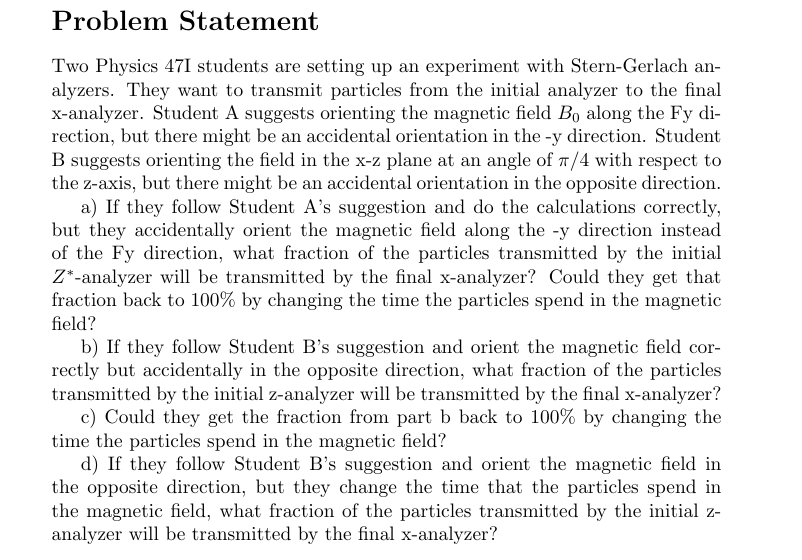Two Physics 471 students want to have some fun. They set up an experiment similar to the one in the previous problem: as before, the first Stern-Gerlach analyzer allows only particles with spin up along the z-axis to pass through, but this time the second Stern-Gerlach analyzer allow only particles with spin up along the x-axis to pass through. The analyzers are separated by a region of space where there is a uniform magnetic field Bo. The students are free to choose the direction of Bo, but they want to arrange it so that 100% of the silver atoms that were transmitte by the first analyzer are also transmitted by the second analyzer. Student A finished the two previous problems and says that they should orient the magnetic fiel Bo along the +ŷ direction so she can use her results from those problems. Student B looked at Figure 3.9(b) in McIntyre and thought it would be cool to orient the field B
Two Physics 471 students want to have some fun. They set up an experiment similar to the one in the previous problem: as before, the first Stern-Gerlach analyzer allows only particles with spin up along the z-axis to pass through, but this time the second Stern-Gerlach analyzer allow only particles with spin up along the x-axis to pass through. The analyzers are separated by a region of space where there is a uniform magnetic field Bo. The students are free to choose the direction of Bo, but they want to arrange it so that 100% of the silver atoms that were transmitte by the first analyzer are also transmitted by the second analyzer. Student A finished the two previous problems and says that they should orient the magnetic fiel Bo along the +ŷ direction so she can use her results from those problems. Student B looked at Figure 3.9(b) in McIntyre and thought it would be cool to orient the field B
Related questions
Question
I need some help with this

Transcribed Image Text:Two Physics 471 students want to have some fun. They set up an experiment similar to the one in the previous problem: as before, the first Stern-Gerlach analyzer allows only particles with spin up along the z-axis to pass through, but this time the second Stern-Gerlach analyzer allows only particles with spin up along the x-axis to pass through. The analyzers are separated by a region of space where there is a uniform magnetic field B0. The students are free to choose the direction of B0, but they want to arrange it so that 100% of the silver atoms that were transmitted by the first analyzer are also transmitted by the second analyzer.
Student A finished the two previous problems and says that they should orient the magnetic field B0 along the +ŷ direction so she can use her results from those problems.
Student B looked at Figure 3.9(b) in McIntyre and thought it would be cool to orient the field B0 in the x-z plane at an angle of 45° with respect to the z-axis. (In spherical coordinates, B0 would be pointing in the **n̂** direction given by θ = π/4 and φ = 0.)
a) If they follow student A’s suggestion, what is the minimum time the particles must spend in the magnetic field so that 100% of the particles transmitted by the initial z-analyzer are transmitted by the final x-analyzer? Define ω₀ = eB₀/m and express your answer in terms of ω₀.
Hint: Although the field is oriented along +y axis rather than the +x axis as in problems 1 and 2, the physics is the same, so the results should be the same.
b) If they follow student B’s suggestion, what is the minimum time the particles must spend in the magnetic field so that 100% of the particles transmitted by the initial z-analyzer are transmitted by the final x-analyzer? Hint: You may be tempted to use Equation (3.48), but that’s not necessary. Take seriously the claim that “expectation values in quantum mechanics obey the laws of classical mechanics” and think about how the direction of the spin vector varies in time. McIntyre’s Figure 3.9(b) should be helpful.
c) If they follow student A’s suggestion and do the calculations correctly, but they accidentally orient the B-field along the -ŷ direction instead of the +ŷ

Transcribed Image Text:**Figure 3.9 Explanation:**
**(a) Spin-Flip Probability Graph:**
This graph shows the spin-flip probability \( p_+ \) as a function of time \( t \). The horizontal axis is time \( t \), and the vertical axis represents the probability \( p_+ \). The graph illustrates periodic behavior, with peaks occurring at approximately \( \frac{2\pi}{\omega_0} \), \( \frac{4\pi}{\omega_0} \), and \( \frac{6\pi}{\omega_0} \). The oscillating shape indicates the likelihood of spin reversal in a system subjected to a uniform magnetic field with components in both the x and z directions.
**(b) Spin Precession Diagram:**
This diagram represents the precession of the expectation value of the spin vector \(\langle S(t) \rangle\) in a coordinate system with axes labeled as x, y, and z. The magnetic field \( B \) is shown pointing diagonally upwards, influencing the spin's precession. The vector \(\langle S(0) \rangle\) represents the initial expectation value of the spin, and \(\langle S(t) \rangle\) illustrates how this expectation value evolves over time, tracing a conical path around the direction of the magnetic field \( B \). This conical movement visualizes Larmor precession, a fundamental concept in quantum mechanics and magnetic resonance.
Expert Solution
Step 1: Problem statement

Step by step
Solved in 3 steps with 7 images
